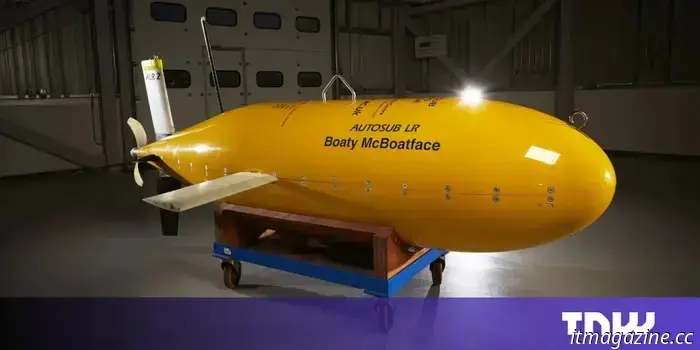
The Boaty McBoatface submarine utilizes NATO-supported quantum technology beneath the waves.
The UK startup Aquark Technologies has utilized Boaty McBoatface, a popular internet-famous submarine, to conduct the first underwater tests of its quantum sensing technology. Backed by NATO, the company placed its "cold atom" system inside the autonomous submarine, which then made its way to the bottom of a large indoor tank at the National Oceanography Centre (NOC) in Southampton.
The purpose of the test was to evaluate how well Aquark’s quantum technology, which requires complete isolation from external disturbances to operate, would perform in the underwater environment characterized by varying temperatures and pressures.
Andrei Dragomir, the co-founder and CEO of the startup, characterized the trial as a “resounding success,” noting that the device functioned as effectively underwater as it does on land. He anticipates that practical uses for the technology will emerge soon.
Aquark’s patented cold atom technology serves as an alternative position, navigation, and timing (PNT) device that operates independently of satellites and is therefore resistant to external interference like GPS disruptions. This capability is particularly beneficial for vehicles such as planes, drones, and submarines, which is why NATO is interested in it. The technology is also capable of detecting tiny variations in gravity due to differing densities in the seabed.
Dr. Alex Phillips, who heads marine autonomous and robotics systems at NOC, believes this technology could greatly enhance underwater navigation and seabed imaging.
Aquark’s "cold atom" quantum sensing relies on cooling atoms—usually of rubidium, a soft, silvery-white metal—to near absolute zero using lasers to create a cold atom "trap." At these extremely low temperatures, the atoms decelerate and exhibit quantum properties.
These quantum atoms are highly sensitive to external factors such as gravity, acceleration, or rotation, allowing scientists to measure acceleration, magnetic fields, rotation, gravity, and time with far greater accuracy than traditional devices like accelerometers, atomic clocks, or gravimeters.
Cold atom traps are the foundation of quantum sensors, similar to how chips are the basis of quantum computers. These sensors have the potential to revolutionize various fields, from air traffic control to subsurface exploration.
While scientists have been trapping atoms using magnetic fields for decades, Dragomir discovered a method to trap atoms without them during his PhD studies.
This innovation leads to systems that are smaller, lighter, less expensive, and more energy-efficient than existing options, as noted by the company previously. Additionally, they are more durable and suitable for challenging environments.
Aquark has already tested its technology aboard a Royal Navy vessel and in a small drone and has now further validated it using the NOC’s Autosub Long Range, affectionately nicknamed Boaty McBoatface following a public poll to name the submarine.
Dragomir is optimistic about Aquark’s future endeavors: “We could potentially measure the density of minerals beneath the seabed through gravity measurements or perform high-sensitivity magnetic field measurements, revealing previously hidden elements,” he mentioned. “We might even discover hidden treasures!”


Other articles
 Tesla reiterates its schedule for an affordable electric vehicle, despite reports suggesting possible delays.
Tesla states that the production of an affordable electric vehicle is still slated for June.
Tesla reiterates its schedule for an affordable electric vehicle, despite reports suggesting possible delays.
Tesla states that the production of an affordable electric vehicle is still slated for June.
 The launch lineup for the Nintendo Switch 2 has been enhanced by Sonic.
Sega has recently revealed new titles for the Nintendo Switch 2 launch lineup that will address the absence of a 3D Mario game.
The launch lineup for the Nintendo Switch 2 has been enhanced by Sonic.
Sega has recently revealed new titles for the Nintendo Switch 2 launch lineup that will address the absence of a 3D Mario game.
 Fertility startup ‘revitalizes’ human eggs to increase the likelihood of conception.
Ovo Labs has created three therapeutic treatments that significantly lower genetic errors in eggs, greatly enhancing the likelihood of conception.
Fertility startup ‘revitalizes’ human eggs to increase the likelihood of conception.
Ovo Labs has created three therapeutic treatments that significantly lower genetic errors in eggs, greatly enhancing the likelihood of conception.
 Hubble marks its 35th anniversary with four stunning new images.
Hubble is celebrating its 35th anniversary, and a collection of stunning new images captured by the telescope has been unveiled.
Hubble marks its 35th anniversary with four stunning new images.
Hubble is celebrating its 35th anniversary, and a collection of stunning new images captured by the telescope has been unveiled.
 Roku introduces two new streaming sticks and reveals intentions to develop projectors.
Roku streamlines its range of streaming devices and hints at a new projector.
Roku introduces two new streaming sticks and reveals intentions to develop projectors.
Roku streamlines its range of streaming devices and hints at a new projector.
 Xfinity Mobile Premium Unlimited Plan: 5 key points to understand
Xfinity Mobile's latest Premium Unlimited plan brings a variety of benefits that you should be aware of.
Xfinity Mobile Premium Unlimited Plan: 5 key points to understand
Xfinity Mobile's latest Premium Unlimited plan brings a variety of benefits that you should be aware of.
The Boaty McBoatface submarine utilizes NATO-supported quantum technology beneath the waves.
Aquark's quantum sensing technology has the potential to provide submarines with accurate navigation and unprecedented capabilities for mapping the ocean floor.
